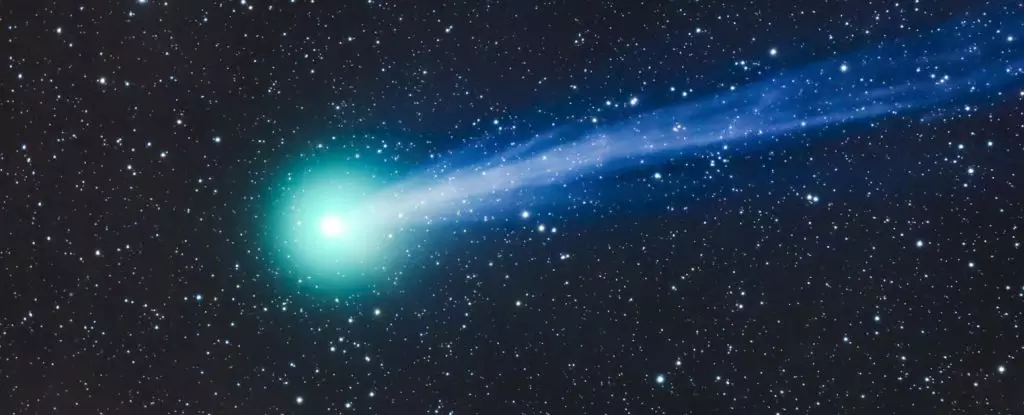The discovery of interstellar comet 3I/ATLAS has ignited both scientific curiosity and public fascination. Unlike typical comets bound within our solar system, 3I/ATLAS hails from beyond, offering a rare glimpse into the composition of other stellar systems. Recent images captured during a total lunar eclipse reveal an intriguing shift in its appearance: a faint, yet distinct, greenish hue surrounding the comet. This color is more than mere aesthetics; it is a clue—a cosmic cipher—that may unlock secrets about the comet’s unique chemistry and its origin.
While green emissions are common among solar system comets, driven by the presence of specific molecules like dicarbon (C2), 3I/ATLAS defies expectations. Despite its greenish glow, astronomers have yet to detect the signature spectral lines of C2 in this interstellar visitor. This discrepancy challenges established notions of cometary chemistry and hints at extraordinary differences—either in the molecules present or the processes at play—in this alien object. The observation provokes a fundamental question: what compounds are responsible for this unexpected coloration, and what does that tell us about the environment from which 3I/ATLAS originated?
The Chemical Paradox: Depleted but Mystifying
The peculiar chemical makeup of 3I/ATLAS defies conventional cometary models. Analyses, including observations from the James Webb Space Telescope, reveal an abundance of carbon dioxide and molecules like nickel and cyanogen (CN), yet conspicuously lack typical carbon-chain molecules such as C2 and C3. These molecules are usually abundant in solar system comets and are primarily responsible for the familiar green fluorescence when energized by solar radiation. Their apparent absence in 3I/ATLAS is not a mere observational oversight; it signifies a potentially fundamental difference in its formation environment or evolutionary history.
The situation becomes more compelling considering the compositional depletion of carbon-chain molecules—elements crucial for certifying the identity of many comets. A preprint led by astronomer Luis Salazar Manzano highlights this anomaly, emphasizing that 3I/ATLAS is among the most carbon-depleted comets ever observed. This chemical profile suggests it may have originated from a star system or a niche niche within another galaxy with environments that favored different chemical pathways, possibly resulting in the distinctive spectral features or lack thereof.
The absence of C2 detection and the unusual composition bear implications beyond mere curiosity. They serve as a testament to the diversity of planetary building blocks across the universe, challenging the universality of our solar system models. Moreover, this chemical enigma underscores the importance of re-evaluating how we interpret cometary spectra—what we see and what we expect are not always aligned.
The Green Glow: More Than a Visual Quirk
The green appearance of 3I/ATLAS might initially seem like a minor visual anomaly—yet, it stands as a cosmic message. In typical solar system comets, the green hue emerges from the fluorescence of C2 molecules, which glow when excited by ultraviolet radiation from the Sun. Given the non-detection of C2 in 3I/ATLAS, the question arises: is the green signature caused by another molecule, or are we witnessing a different excitation process altogether?
One possibility is that a yet-to-be-identified molecule is responsible for the fluorescence, perhaps unique to the chemical environment of the comet’s parent system. Alternatively, the comet’s unusual composition could mean that a different molecular mechanism, perhaps involving cyanogen or even complex hydrocarbons, is producing the greenish tint. If confirmed, such a shift in the emission source would redefine our understanding of cometary emissions and chemical diversity in the galaxy.
From an observational perspective, this green glow is a fascinating reminder of how much remains unknown. Future spectroscopic studies could unveil the molecule or process behind the hue, offering a new lens into the molecular diversity of interstellar objects. These insights might also influence how we interpret the signals from other exoplanetary objects, expanding our knowledge of chemical evolution beyond the confines of our solar neighborhood.
Gazing Into the Future: Unlocking Cosmic Diversity
As 3I/ATLAS moves closer to Earth later this year, astronomers are poised for an unprecedented opportunity. Its close approach offers a rare chance for detailed analysis, potentially revealing its elusive chemical makeup and the origins of its green glow. Every data point collected will be a piece of a complex puzzle—one that has the potential to challenge or even redefine longstanding models of comet chemistry.
This interstellar visitor acts as a natural laboratory—an artifact not formed within our solar system, but from another star. Its composition could reflect the diversity of planetary formation processes elsewhere, suggesting that the ingredients for life—or at least the building blocks of planetary systems—are more varied than previously imagined. The ongoing study of 3I/ATLAS stands as a testament to our relentless quest for understanding the universe’s intricacies, continuously pushing the boundaries of what we believe is possible.
In the coming months, astronomers and astrophysicists worldwide will scrutinize every spectral signature, chemical trace, and visual detail. The hope is that this interstellar traveler will not only reveal its own secrets but also shed light on the broader cosmic narrative—one that spans billions of years and countless star systems. The green glow seen during that lunar eclipse might just be the beginning of a new chapter in interstellar chemistry, one that challenges our assumptions and propels us toward a deeper, more nuanced understanding of the universe’s complexity.

